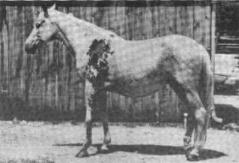*Al-Hamdaniah
Let me share with you this picture of one of my all-time favorite desert-bred Arabian mares. *Al-Hamdaniah, the bloody-shouldered mare, was a present from the governor of the oil-rich al-Hasa province of Saudi Arabia to Admiral Richard Lansing Connolly, who brought her to the USA in 1947. Superstitious Bedouins believed that the large reddish spots on some horses’ shoulders were the blood of slain warriors, and considered that these horses brought bad luck to their owners. Others, on the contrary, valued these marks as a sign of purity and good breeding. Take a look at similar markings on the body of the mare Helwah, a Maanaghiyah Sbailiyah born in the Syrian desert in the early 1970s.

I saw a daughter of *Al Hamdaniah’s, a mare named Blue Star, by Ibn Fadl (*Fadl x *Turfa). Frank Hannesschlager, who had an outstanding eye for a horse and was raised on a farm in Bavaria at a time when horses were still used for daily work, considered Blue Star one of the best Arabian mares he had ever seen. She was 22 years old when Frank took me to see her, but she had type, structure, and balance in spades.
You are lucky to have seen her. Do you have pictures?
I did not take any pictures of Blue Star, unfortunately.
I have a pure Hamdanieh mare from The Royal Stud of Bahrain. She is dark bay and this summer is due to foal to my Bahraini stallion Krayaan Dilmun. Whilst I was in Bahrain I saw the full sister of Krayaan Dilmun and she was marshoosh (speckled) and had the same blood mark on her shoulder as the mare in the photo.
Jenny
This photo by Randy Abler of some of the mares at Craver Farms shows Pirouette CF on the far left. Her “bloody” marking shows on the right side of her barrel.
Mare IDs, L to R: Pirouette CF, Affinity CF, Chrysalis CF (chestnut), Wisteria CF (gray), Soliloquy CF (bay). The chestnut and the bay in the far back are not identified yet.
Thanks Jenny. Do you have a picture of the sister of your stallion to send?
Yes I do have a photo of the Al Kray mare with the bloody shoulder I will try and load it up over the weekend. It was one taken pre digital days so I need to find it in the ‘big box’ of photos I have!
Jenny
Thanks, Jenny, we are all really looking forward to see it.
Edouard,
Wonderful blog – thank you! I doubt I’ll have much to contribute, but am very much looking forward to a learning experience.
Ray Ellis
The bloody shoulder story is quite interesting. I like to believe the one that tells about the mare who carried her wounded master home, his blood on her shoulder and then foaled a filly with the bloody shoulder.
Also interesting is another mare I know of, owned by Liz Dieter. EAI Hasimmah. She has incredible bloody shoulder markings. But guess what? Her tail female goes to Bint El Bahrein (Egypt*64)! You can see her on Liz’s website: http://www.jevafarms.com (the bloody shoulder tale is also there) 🙂
Ray Ellis
I wish I could have seen *Al Hammdaniah because loved the pictures of her also. Visiting the Otts in 1977 I did see her daughter Bint Sirecho an excellent mare, with excellent clean bone and very fine skin. I also saw Bint Sirecho’s daughter by Sirecho, Hamdaniyah who was a very heavily flea-bitten mare like *Al Hamdaniah and if any of those speckles were closer together she too, would have had a bloody marking. I have movies of those mares. They left a very favorable impression on me.
Hello All do any of you know AlHammdaniah sub strain name? I been asking but no answers. And what about Turfa” blue star breeders say she Abbayyan and others say Kuhaylan which one is really correct from the Saudi documentation the ones that bred her. I hope some one can answer these questions for me.
Abu Uwais Al-Mahgribi
Hi Abu Uwais Al-Mahgribi
I answer you AlHammdaniah sub strain name is Hamedani Samari
Turfa strain Kehila alajuz
I have a mare tail female Al Hamdaniah. I am interested in racing. What is the history on this horse as far as racing is concerned.
Chris
I was also fortunate to see Blue Star with Frank Hannesschlager when she was about 18 years old. The photos I took of the Blue Stars did not turn out well, as the barn was fairly dark, so were discarded years ago. Perhaps a shame, but individuals were barely discernible.
Hello, is there any more information on the mare Helwah, born in the Syrian desert ? Thank you
which mare Helwah? 20 years ago or 50 years ago or 70 years ago?